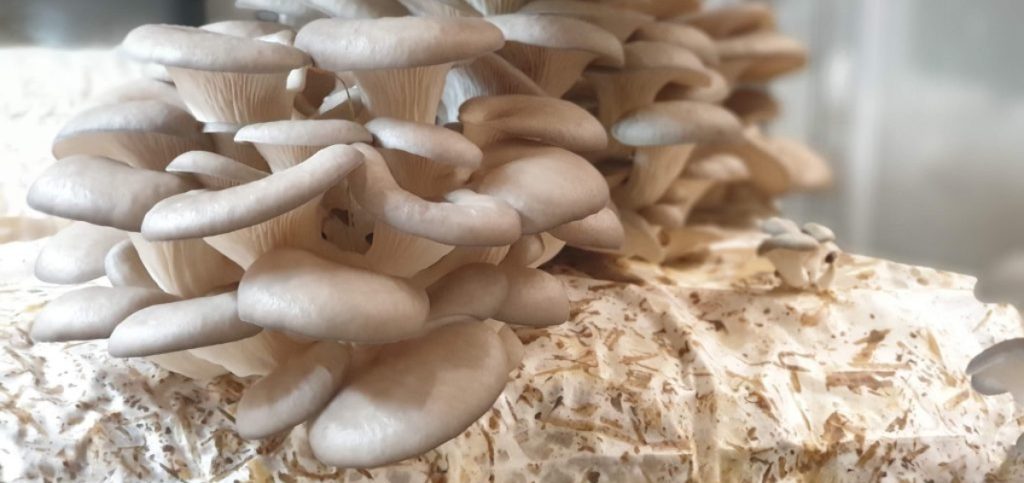The delicious gourmet mushrooms people love to eat are actually the fruiting bodies of a larger hidden fungus.
Mushrooms only appear for a short period of the fungi’s life cycle and their function, like other fruit, is to produce and distribute seed-like mushroom spores for reproduction.
But, fungi won’t grow or produce mushrooms unless environmental conditions are right, and they can remain dormant for many years waiting for suitable fruiting conditions.
To successfully grow mushrooms at home, you’ll need to provide specific growing conditions that vary depending on the mushroom species you want to grow.
If you’re a first-time mushroom grower, we recommend starting with easy-to-grow oyster mushrooms as they’re not only delicious but also fast-growing and hardy.
Read on to discover what conditions are needed for a mushroom to grow and how to create these conditions at home for oyster mushrooms.
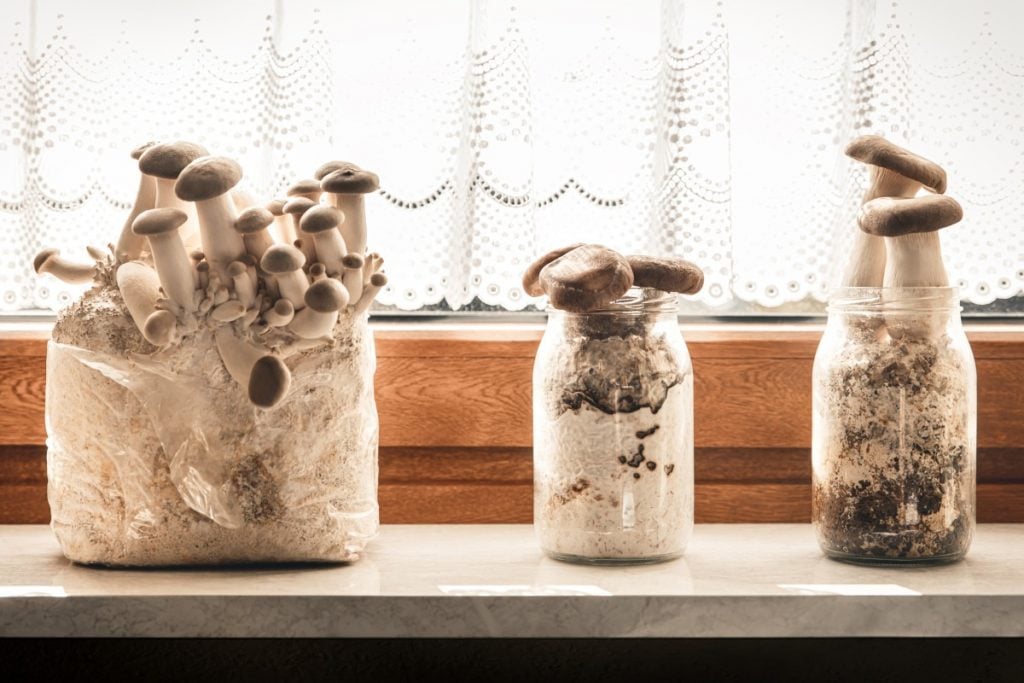
Conditions Needed for Growing Mushrooms at Home
Growing oyster mushrooms at home may be easier than you think, and you don’t need expensive equipment or a grow room to start.
Depending on the mushroom strain and the climate in your area, you could grow fresh oyster mushrooms on your kitchen countertop.
The easiest way for beginners to grow oyster mushrooms is with a mushroom grow kit that contains a fully colonized substrate block.
The mushroom growing process has different phases that each need specific environmental conditions.
When using a grow kit, you only need to provide fruiting conditions as grow kit suppliers do the incubation part of the process for you.
But, if you want to start with mushroom spawn and experience the entire growing process, you’ll need to provide suitable conditions for both colonization and fruiting.
People who regularly grow mushrooms often use fruiting chambers to create and maintain ideal conditions.
These come in several shapes and sizes, from small totes to large walk-in grow tents or grow rooms that are beneficial if you plan on starting a small-scale mushroom farm.
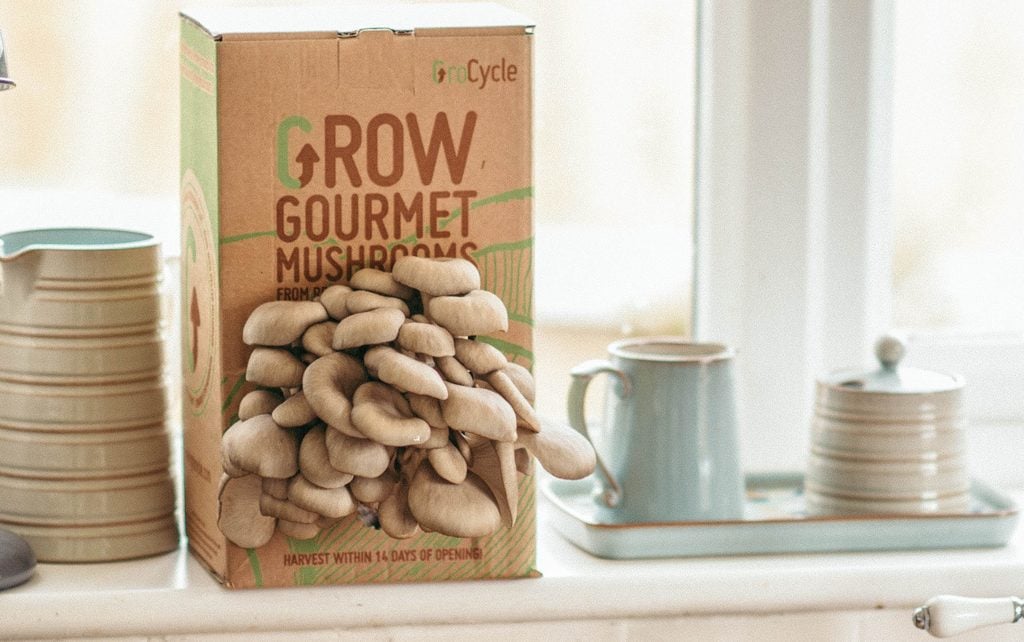
What Conditions Are Needed During the Colonization Phase?
During colonization, mushrooms need warm, humid conditions with good fresh air exchange.
Your substrate will provide the moisture and nutrients required for growth. You simply need to ensure that temperatures and fresh air exchange are correct.
During colonization, also known as incubation, you leave your inoculated substrate in a spot with suitable conditions for 2 to 3 weeks.
During this time, the mycelium grows from the grain spawn you introduced and spreads throughout the substrate.
In the wild, colonization happens underground or inside decaying logs or stumps. Bear this in mind when growing mushrooms, as you should aim to mimic ideal natural conditions.
The following conditions are needed during colonization:
1. Nutritious Growing Medium
A growing medium or substrate is moist organic material that provides the moisture, nutrients and energy that mushroom mycelium needs to grow and fruit.
Different mushroom species prefer different substrates, and it’s important to use the correct substrate for each.
A good substrate is slightly acidic, free of competing organisms and has the correct amount of moisture.
It should also have a structure that enables air exchange and provides the right combination of nutrients for your mushrooms.
Oyster mushrooms aren’t fussy and will grow on several substrates, including straw, sawdust, used coffee grounds and cardboard.
Our complete guide to mushroom substrates has more information on different substrates and how to prepare them for mushroom growing.
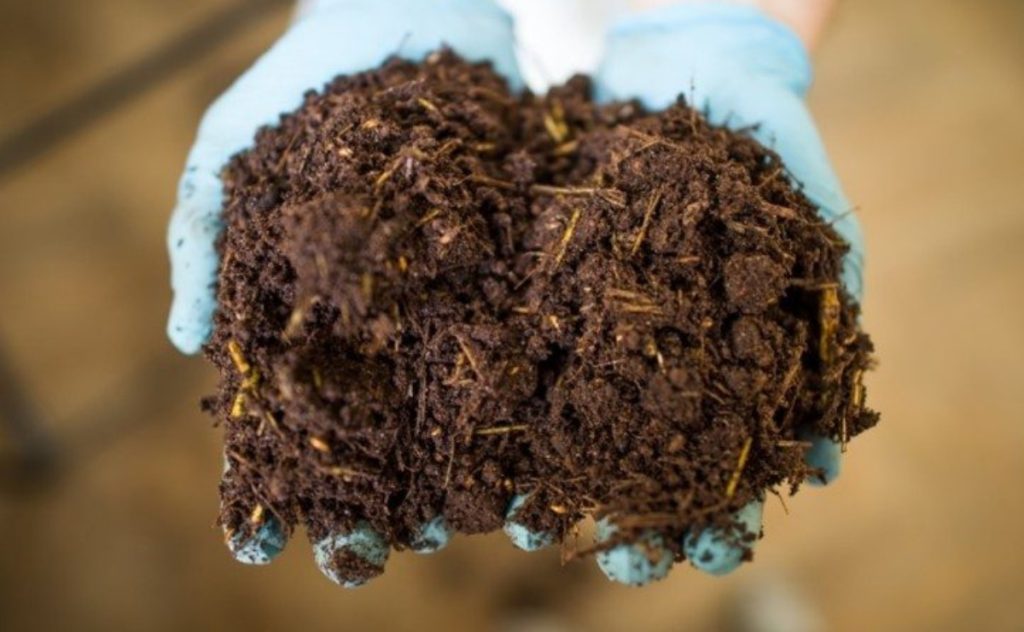
2. Ideal Temperatures
Ideal temperatures for colonization vary by species, and some mushrooms tolerate a broader range of temperatures than others.
Temperatures also play a role in how quickly the mycelium colonizes the substrate.
Cooler temperatures often slow down colonization, and while higher temperatures may speed up the process, they can increase the chances of contamination.
It’s worth researching the species you want to grow and providing optimal temperatures for colonization.
Oyster mushrooms are one of the easiest mushroom species to grow at home, and normal room temperatures of 68-75°F (20 – 24°C) are perfect for them during colonization.
3. Fresh Air Exchange
Mushrooms need to breathe. Like humans, they consume oxygen and release CO2.
During colonization, mushroom mycelium tolerates higher levels of CO2 as it’s often underground, but it still needs enough fresh air exchange to breathe.
If you’re growing mushrooms in mushroom growing bags, your substrate should get enough air exchange through the breathable filter patches or micro-perforations in the growing bags.
Sometimes, if your substrate has smaller particles, like sawdust, it can become compacted and not allow enough fresh air exchange in the center of the substrate.
When this happens, the mycelium will not colonize the center of the substrate.
To prevent this, we recommend using chopped straw or sugarcane bagasse when growing mushrooms in 5-gallon (20 liter) buckets or large containers.
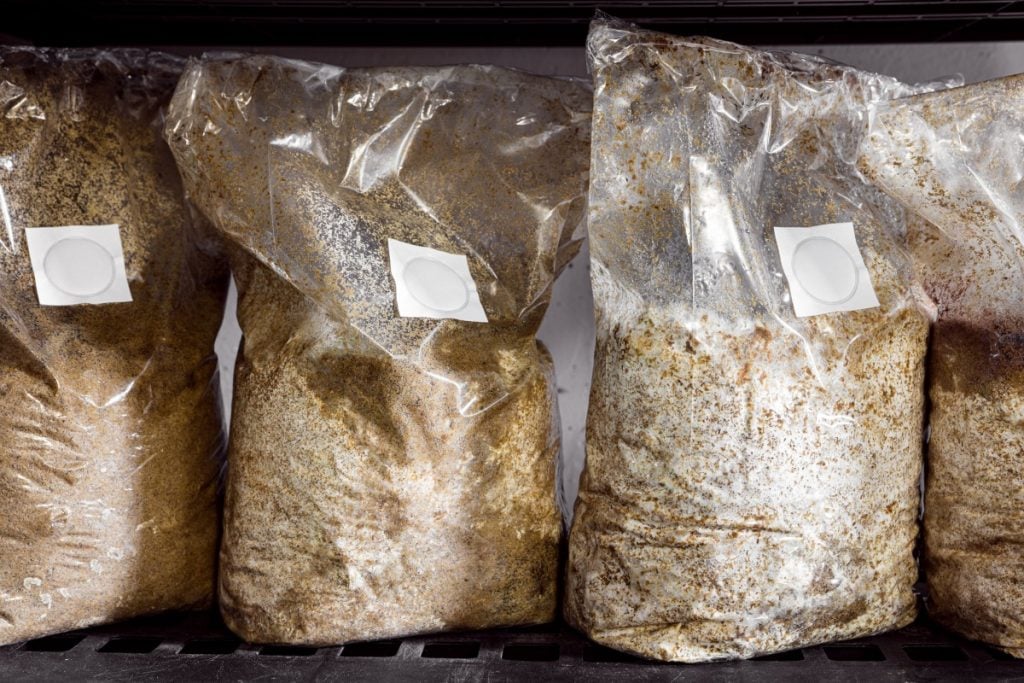
4. Good Air Circulation
As the mycelium grows and feeds on the substrate, it produces heat that increases the temperature inside the substrate.
This process is called thermogenesis and can result in higher temperatures inside the substrate than in the room.
Good air circulation in the room where you’re incubating your mushrooms will help to prevent the substrate from overheating.
The internal substrate temperature when growing oyster mushrooms should be a maximum of 77- 89°F (25-32°C). If the temperature gets higher than this, your mycelium could die.
It also helps to keep the room a couple of degrees lower than the suggested maximum temperatures to allow for thermogenesis.
5. No or Low Light
Keeping your mushrooms in the dark during incubation mimics natural conditions and helps prevent early pinning.
But you don’t need complete darkness. A cupboard, box, dark room or basement will do the trick.
Mushrooms will not switch to the fruiting phase until the mycelium has fully colonized the substrate, AND it’s provided with suitable fruiting conditions.
You’ll know colonization is complete when mycelium has completely covered the substrate and you begin to see hyphal knots and baby mushroom pins.
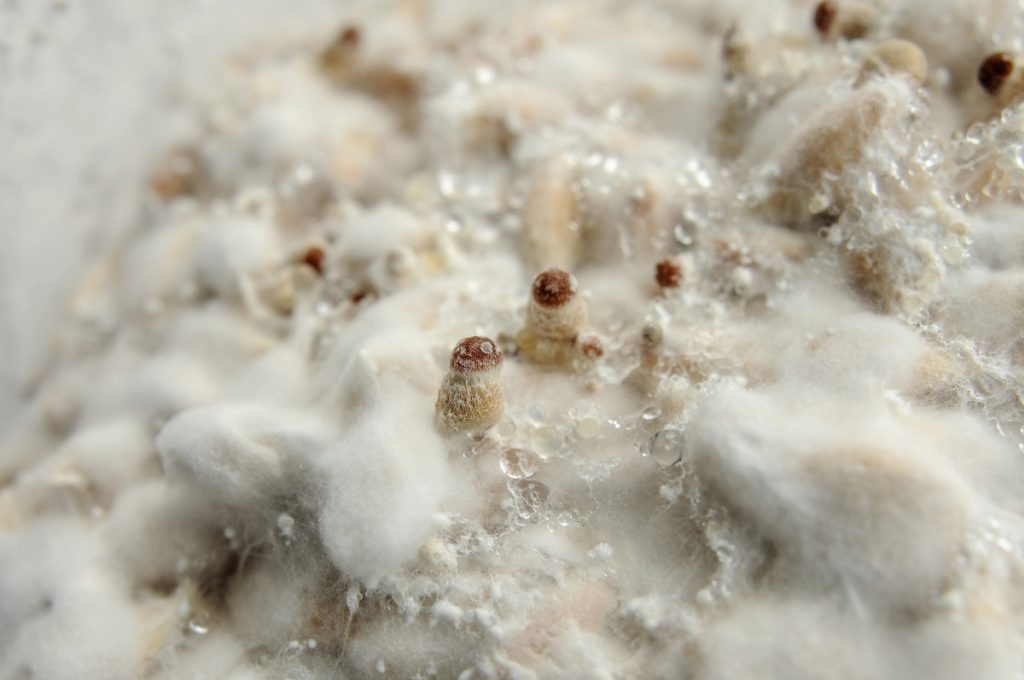
What Conditions Are Needed During the Fruiting Phase
Mushrooms need the right combination of temperature, light, humidity, and fresh air to create healthy, well-formed fruiting bodies.
The fruiting phase is the most exciting phase of the mushroom growing process as you finally get to watch your mushrooms grow.
But, it’s also the phase that needs the most monitoring to ensure the right balance of humidity and fresh air exchange.
One of the easiest ways to create the right conditions is with a fruiting chamber, and there are several easy, DIY options available for small-scale mushroom growers.
Here are the conditions your mushrooms need during the fruiting phase:
1. Indirect Light
Unlike plants, fungi don’t need light to produce food for growth as they absorb nutrients from the organic matter around them.
But, although mycelium does not need light to grow inside a bag or substrate block, some species need light to trigger mushroom production.
In the wild, sunlight indicates to the mycelium that it has reached the surface of the substrate and can now produce mushrooms.
As fungi use mushrooms to distribute spores using wind, water or animals, they must be outside the substrate.
Producing mushrooms underground or inside a decaying stump would be ineffective and a waste of energy.
To mimic nature, place your mushrooms in a spot with indirect natural light near a window or on a shaded windowsill.
But avoid direct sunlight as it may increase temperatures too much and dry the mushrooms out.
And, if you’re growing mushrooms in a windowless space or using a monotub, shotgun fruiting chamber, Martha grow tent or mushroom grow tent, you can use artificial lighting.
To make it easier, use a timer to switch the lights on and off, and aim to provide 12 hours a day of 6500-9000K white or blue light.
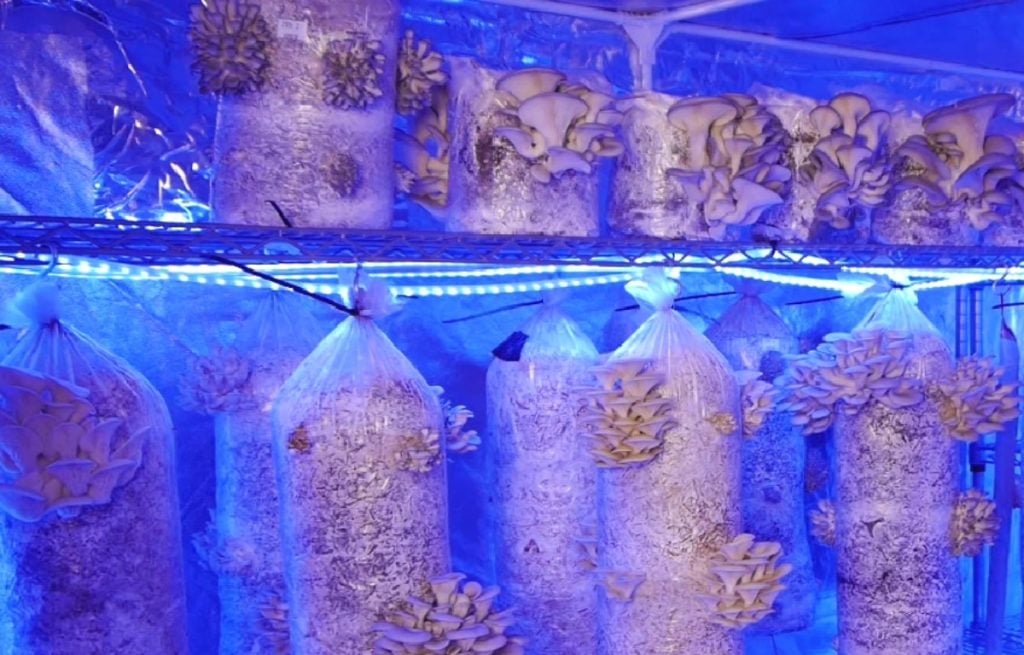
2. High Humidity
Moisture is crucial for mushroom growth both in the substrate and the surrounding environment.
During the fruiting stage, your oyster mushrooms need relative humidity levels of 80 – 95%.
High humidity is especially important during pinning because if baby mushroom pins completely dry out, they stop growing.
Depending on your location, you can often maintain high humidity by misting your mushrooms with water twice a day.
But, people who live in hot, dry climates may need to use a humidity tent made from a plastic bag to help maintain humidity levels.
Growers using fruiting chambers can automate the process by linking a humidifier to a humidity regulator. Doing this will ensure that humidity levels remain in the correct range throughout fruiting.
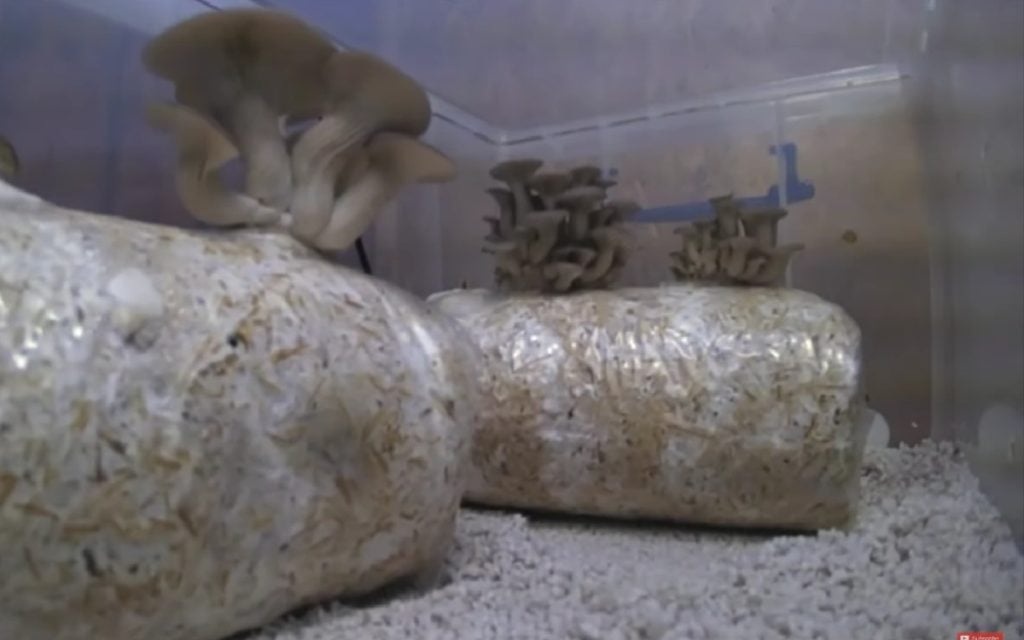
3. Optimal Temperatures
Optimal fruiting temperatures for oyster mushrooms vary depending on the strain but are usually between 50-77°F (10-25°C), making them easy to grow indoors in most homes.
Most oyster mushrooms are not too fussy, and although they’ll grow best in their ideal temperature range should still fruit in temperatures of between 50-86°F (10-30°C.)
If you live in a climate with extreme temperatures and want to grow mushrooms indoors year-round, then a fruiting chamber with temperature regulation is a must.
4. Fresh Air Exchange
In the wild, mushrooms grow out of logs, stumps or leaf litter into fresh, oxygen-rich air.
Fresh air with CO2 levels of less than 1000ppm is the other indicator that tells mycelium it has reached the surface and can now produce mushrooms.
Cutting holes in your grow bag, uncovering bucket and tub holes or removing the lids on bottles and jars signals to the mycelium that there’s space to produce mushrooms.
Take care when using a humidity tent or fruiting chamber to ensure there’s enough fresh air exchange to keep the CO2 levels low.
If CO2 levels increase, it affects the mushroom’s growth, and you may end up with small caps and long skinny stems.
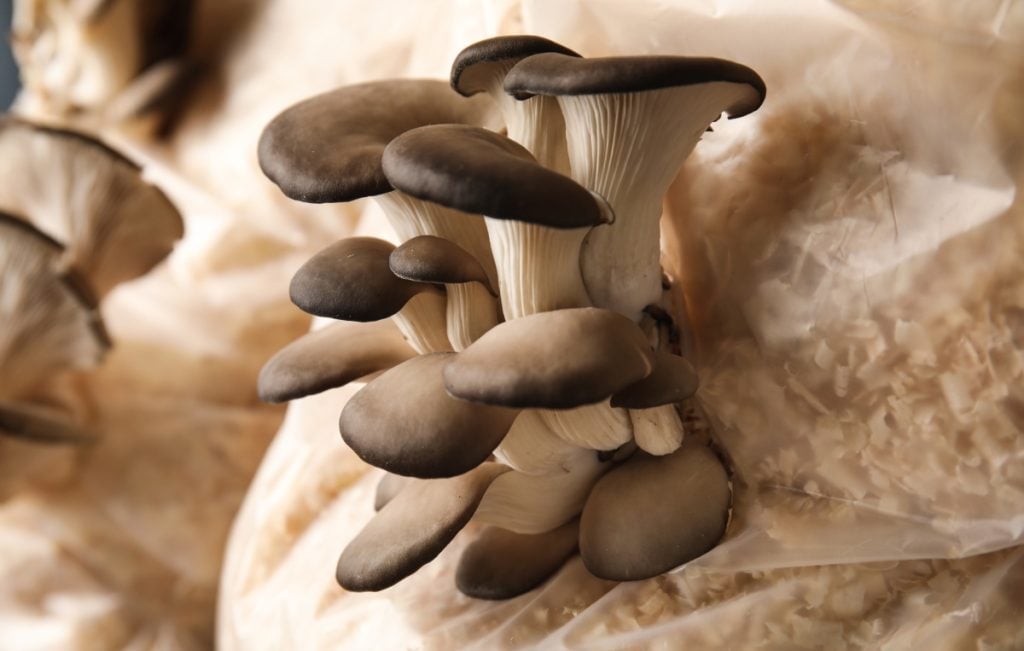
Common Issues With Growing Conditions and How to Troubleshoot Them
Learning to grow mushrooms is like any other skill. To discover what works best for you and the mushroom species you’re growing takes practice and experimentation.
Here are some common growing condition issues and how to avoid them:
Weak Mycelial Growth
Using the incorrect substrate or a substrate without all the nutrients required for growth can cause weak mycelial growth.
Before you begin, research the type of mushrooms you want to grow and learn which is the best substrate for them.
Poor air exchange or substrate that’s too dry will also lead to poor mycelial growth and patches of uncolonized substrate.
Make sure your bag or container has enough holes to allow fresh air exchange but not so many that the substrate dries out.
If you are not using mushroom grow bags, try covering the holes in your bag or container with micropore to allow fresh air exchange while retaining moisture.
Contamination
Mushrooms are not the only fungi that enjoy warm, humid conditions. Mold and other bacteria also thrive in the conditions you create for your mushrooms.
As a result, mushroom contamination is the most common issue encountered by mushroom growers.
Several things increase the chances of contamination, including:
- Incorrect pasteurization or sterilization
- Poor quality substrate
- A substrate that is too wet
- High temperatures inside the substrate
To reduce the chances of contamination, ensure your work surface, hands and tools are clean and take the time to pasteurize or sterilize your substrate correctly.
When inoculating your substrate, do a squeeze test to check the moisture content is correct before proceeding.
To avoid the substrate overheating, monitor temperatures in the room where you keep your mushrooms during incubation.
Mushroom Pins Aborting
The most common reason mushroom pins stop growing is a lack of humidity.
To prevent this, mist your mushroom grow kit at least twice a day or use a fruiting chamber to maintain humidity levels of 80-95%.
Final Thoughts
Fungi won’t produce mushrooms unless environmental conditions are right. To grow mushrooms at home successfully, you’ll need to mimic these conditions as closely as possible.
Nature makes it look easy, but depending on your climate, it can be tricky to provide enough fresh air exchange and maintain high levels of humidity.
And, it’s not only the growing conditions that dictate whether you succeed or fail. Mushroom strain and spawn quality will also affect yields.
It’s best to use good quality mushrooms spawn sourced from a reputable supplier and, for higher yields, grow mushroom strains that have proven their worth for commercial cultivation.
If you plan on growing new strains from spore prints, you risk growing mushrooms that don’t perform reliably no matter how good the conditions are.
But it can be fun to experiment sometimes and see what you get.
Try one of our online mushroom cultivation courses to learn more about growing oyster mushrooms as a beginner or as someone looking to start a low-tech mushroom farm.
These courses guide you through the entire mushroom growing process and provide details on all the growing conditions so you don’t have to guess.
